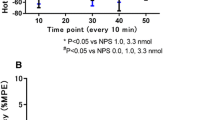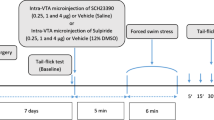Abstract
d-kyotorphin (d-Kyo) is a synthetic analogue of the neuropeptide kyotorphin and produces naloxone reversible analgesia. Stress-induced analgesia (SIA) is an in-built mammalian pain-suppression response that occurs during or following exposure to a stressful stimulus. The periaqueductal gray (PAG) is implicated as a critical site for processing strategies for coping with different types of stress and pain and NO affects its activity. The objectives of the present study were twofold: (1) to examine the effects of d-Kyo (5 mg/kg) on acute immobilization SIA; (2) to investigate the effect of peptide on NO activity in rat PAG after the stress procedure mentioned above. All drugs were injected intraperitoneally in male Wistar rats. The nociception was measured by the paw pressure and hot plate tests. A histochemical procedure for nicotinamide adenine dinucleotide phosphate–diaphorase (NADPH-d)-reactive neurons was used as indirect marker of NO activity. Our results revealed that d-Kyo has modulating effects on acute immobilization stress-induced analgesia in rats may be by opioid and non-opioid systems. Although d-Kyo is incapable of crossing the blood–brain barrier it showed an increased number of NADPH-d reactive neurons in dorsolateral periaqueductal gray (dlPAG) in control but not in stressed groups. We may speculate that the effect of d-Kyo in the brain is due to structural and functional interaction between opioidergic and NO-ergic systems or d-Kyo appears itself as a stressor. Further studies are needed to clarify the exact mechanisms of its action.




Similar content being viewed by others
References
Aloisi AM, Ceccarelli I, Lupo C (1998) Behavioural and hormonal effects of restraint stress and formalin test in male and female rats. Brain Res Bull 47:57–62
Amir S, Amit Z (1978) Endogenous opioid ligands may mediate stress-induced changes in the affective properties of pain related behavior in rats. Life Sci 23:1143–1151
Amit Z, Galina ZH (1988) Stress induced analgesia plays an adaptive role in the organization of behavioral responding. Brain Res Bull 21:955–958
Appelbaum BD, Holtzman SG (1985) Restraint stress enhances morphine-induced analgesia in the rat without changing apparent affinity of receptor. Life Sci 36:1069–1074
Basbaum AI, Fields HL (1984) Endogenous pain control systems: brainstem spinal pathways and endorphin circuitry. Annu Rev Neurosci 7:309–338
Behbehani MM (1995) Functional characteristics of the midbrain periaqueductal gray. Prog Neurobiol 46:575–605
Bocheva AI, Dzambazova EB (2009) Opioidergic system and second messengers affected the nociceptive effects of Tyr-MIF-1’s after three models of stress. Bulg Chem Commun 41:153–159
Bodnar RJ (1990) Effects of opioid peptides on peripheral stimulation and ‘stress’-induced analgesia in animals. Crit Rev Neurobiol 6:39–49
Bronnikov G, Dolgacheva L, Zhang SJ, Galitovskaya E, Kramarova L, Zinchenko V (1997) The effect of neuropeptides kyotorphin and neokyotorphin on proliferation of cultured brown preadipocytes. FEBS Lett 407:73–77
Butler RK, Finn DP (2009) Stress-induced analgesia. Prog Neurobiol 88(3):184–202
Carrasco GA, Van de Kar LD (2003) Neuroendocrine pharmacology of stress. Eur J Pharmacol 463:235–272
Choi S, Lee J, Suh H (2003) Effect of ginsenosides administered intrathecally on the antinociception induced by cold water swimming stress in the mouse. Biol Pharm Bull 26:858–861
Contet C, Gavériaux-Ruff C, Matifas A, Caradec C, Champy MF, Kieffer BL (2006) Dissociation of analgesic and hormonal responses to forced swim stress using opioid receptor knockout mice. Neuropsychopharmacol 31:1733–1744
Costa A, Trainer P, Besser M, Grossman A (1993) Nitric oxide modulates the release of corticotropin-releasing hormone from the rat hypothalamus in vitro. Brain Res 605:187–192
Dzambazova EB, Bocheva AI, Nikolova VP (2009) Involvement of endogenous nitric oxide in the effects of kyotorphin and its synthetic analogue on immobilization and cold stress-induced analgesia. Bulg Chem Commun 41:116–121
Fujita T, Kishida T, Okada N, Ganapathy V, Leibach FH, Yamamoto A (1999) Interaction of kyotorphin and brain peptide transporter in synaptosomes prepared from rat cerebellum: implication of high affinity type H+/peptide transporter PEPT2 mediated transport system. Neurosci Lett 271:117–120
Gilinsky MA, Petrakova GM, Amstislavskaya TG, Maslova LN, Bulygina VV (2005) Hypothalamic monoamines in cold stress on the background of changes in the activity of the nitric oxide system. Neurosci Behav Physiol 35:171–175
Gioia M, Bianchi R (1988) The distribution of substance P and Met-enkephalin in the periaqueductal gray matter of the rat. Basic Appl Histochem 32:103–108
Hara S, Kuhns ER, Ellenberger EA, Mueller JL, Shibuya T, Endo T, Quock RM (1995) Involvement of nitric oxide in intracerebroventricular β-endorphin-induced neuronal release of methionine enkephalin. Brain Res 675:190–194
Hodges BL, Gagnon MJ, Gillespie TR, Breneisen JR, O’Lealy DF, Hara S, Quock RM (1994) Antagonism of nitrous oxide antinociception in the rat hot plate test by site-specific mu and epsilon opioid receptors blockade. J Pharmacol Exp Ther 269:596–600
Hope BT, Michael GJ, Knigge KM, Vincent SR (1991) Neuronal NADPH–diaphorase is a nitric oxide synthase. Proc Natl Acad Sci USA 88:2811–2820
Hori N, Lee MC, Sasaguri K, Ishii H, Kamei M, Kimoto K, Toyoda M, Sato S (2005) Suppression of stress-induced nNOS expression in the rat hypothalamus by biting. J Dent Res 84:624–628
Ignarro LJ (1990) Biosynthesis and metabolism of endothelium-derived nitric oxide. Annu Rev Pharmacol 30:535–560
Inoue M, Yamada T, Ueda H (1999) Low dose of kyotorphin (tyrosine-arginine) induces nociceptive responses through a substance P release from nociceptor endings. Mol Brain Res 69:302–305
Karanth S, Lyson K, McCann SM (1993) Role of nitric oxide in interleukin 2-induced corticotropin-releasing factor release from incubated hypothalamus. Proc Natl Acad Sci USA 90:3383–3387
Lapo IB, Konarzewski M, Sadowski B (2003) Effect of cold acclimation and repeated swimming on opioid and nonopioid swim stress-induced analgesia in selectively bred mice. Physiol Behav 78:345–350
Lopes SC, Fedorov A, Castanho MA (2006) Chiral recognition of d-kyotorphin by lipidic membranes: relevance toward improved analgesic efficiency. Chem Med Chem 1:723–728
Matsumoto T, Nakane M, Pollock JS, Kuk JE, Forstermann U (1993) A correlation between soluble brain nitric oxide synthase and NADPH-d activity is only seen after exposure of the tissue to fixative. Neurosci Lett 155:61–64
McDonald CE, Gagnon MJ, Ellenberger EA, Hodges BL, Ream JK, Tousman SA, Quock RM (1994) Inhibitors of nitric oxide synthesis antagonize nitrous oxide antinociception in mice and rats. J Pharmacol Exp Ther 269:601–608
Ochi T, Motoyama Y, Goto T (2000) The spinal antinociceptive effect of FR140423 is mediated through kyotorphin receptors. Life Sci 66:2239–2245
Onstott D, Mayer B, Beitz AJ (1993) Nitric oxide synthase immunoreac-tive neurons anatomically define a longitudinal dorsolateral column within the midbrain periaqueductal gray of the rat: analysis using laser confocal microscopy. Brain Res 610:317–324
Pacák K, Palkovits M (2001) Stressor specificity of central neuroendocrine responses: implications for stress-related disorders. Endocr Rev 22:502–548
Paxinos G, Watson C (1986) The rat brain in stereotaxic coordinates. Academic Press, Orlando
Rodella L, Rezzani R, Agostini C, Bianchi R (1998) Induction of NADPH–diaphorase activity in the rat periaqueductal gray matter after nociceptive visceral stimulation. Brain Res 793:333–336
Rodgers RJ, Randall JI (1988) Environmentally induced analgesia: situational factors, mechanisms and significance. In: Rodgers RJ, Cooper SJ (eds) Endorphins, opiates and behavioural processes. John Wiley & Sons, New York, pp 107–142
Sandkühler J (1996) The organization and function of endogenous antinociceptive systems. Prog Neurobiol 50:49–81
Sargent DF, Schwyzer R (1986) Membrane lipid phase as catalyst for peptide-receptor interactions. Proc Natl Acad Sci USA 83:5774–5778
Saxon DW, Beitz A (1996) Induction of NADPH–diaphorase/nitric oxide synthase in the rat brainstem trigeminal system resulting from cerebellar lesions. J Comp Neurol 371:41–71
Stone TW (1983) A comparison of the effects of morphine, enkephalin, kyotorphin and d-phenylalanine on rat central neurones. Br J Pharmacol 79:305–312
Takagi H, Shiomi H, Ueda H, Amano H (1979a) A novel analgesic dipeptide from bovine brain is a possible Met-enkephalin releaser. Nature 282:410–412
Takagi H, Shiomi H, Ueda H, Amano H (1979b) Morphine-like analgesia by a new dipeptide, l-tyrosyl-l-arginine (Kyotorphin) and its analogue. Eur J Pharmacol 55:109–111
Takagi H, Shiomi H, Kuraishi Y, Ueda H (1982) Analgesic dipeptide, l-Tyr-d-Arg (d-kyotorphin) induces Met-enkephalin release from guinea pig striatal slices. Experientia 38:1344–1345
Teuscher NS, Keep RF, Smith DE (2001) PEPT2-mediated uptake of neuropeptides in rat choroid plexus. Pharm Res 18:807–813
Tsuda A, Ida Y, Satoh H, Tsujimaru S, Tanaka M (1989) Stressor predictability and rat brain noradrenaline metabolism. Pharmacol Biochem Behav 32:569–572
Ueda H, Yoshihara Y, Misawa H, Fukushima N, Katada T, Ui M, Takagi H, Satoh M (1989) The kyotorphin (tyrosine-arginine) receptor and a selective reconstitution with purified Gi, measured with GTPase and phospholipase C assays. J Biol Chem 264:3732–3741
Uribe RM, Lee S, Rivier C (1999) Endotoxin stimulates nitric oxide production in the paraventricular nucleus of the hypothalamus through nitric oxide synthase I: correlation with hypothalamic-pituitary-adrenal axis activation. Endocrinology 140:5971–5981
Vaccarino AL, Clemmons HR, Mader GJ Jr, Magnusson JE (1997) A role of periaqueductal grey NMDA receptors in mediating formalin-induced pain in the rat. Neurosci Lett 236:117–119
Watkins LR, Mayer DJ (1986) Multiple endogenous opiate and non-opiate analgesia systems: evidence of their existence and clinical implications. Ann NY Acad Sci 467:273–299
Xing J, Li J (2007) TRPV1 receptor mediates glutamatergic synaptic input to dorsolateral periaqueductal gray (dl-PAG) neurons. J Neurophysiol 97:503–511
Xing J, Li DP, Li J (2008) Role of GABA receptors in nitric oxide inhibition of dorsolateral periaqueductal gray neurons. Neuropharmacol 54:734–744
Yajima H, Ogawa H, Ueda H, Takagi H (1980) Studies on peptides. XCIV. Synthesis and activity of kyotorphin and its analogues. Chem Pharm Bull 28:1935–1938
Yamada K, Nabeshima T (1995) Stress-induced responses and multiple opioid systems in the brain. Behav Brain Res 67:133–145
Acknowledgments
This work was supported by Grant 3-D/2007 of the Medical University of Sofia, Bulgaria.
Author information
Authors and Affiliations
Corresponding author
Rights and permissions
About this article
Cite this article
Dzambazova, E.B., Landzhov, B.V., Bocheva, A.I. et al. Effects of d-kyotorphin on nociception and NADPH-d neurons in rat’s periaqueductal gray after immobilization stress. Amino Acids 41, 937–944 (2011). https://doi.org/10.1007/s00726-010-0793-y
Received:
Accepted:
Published:
Issue Date:
DOI: https://doi.org/10.1007/s00726-010-0793-y




